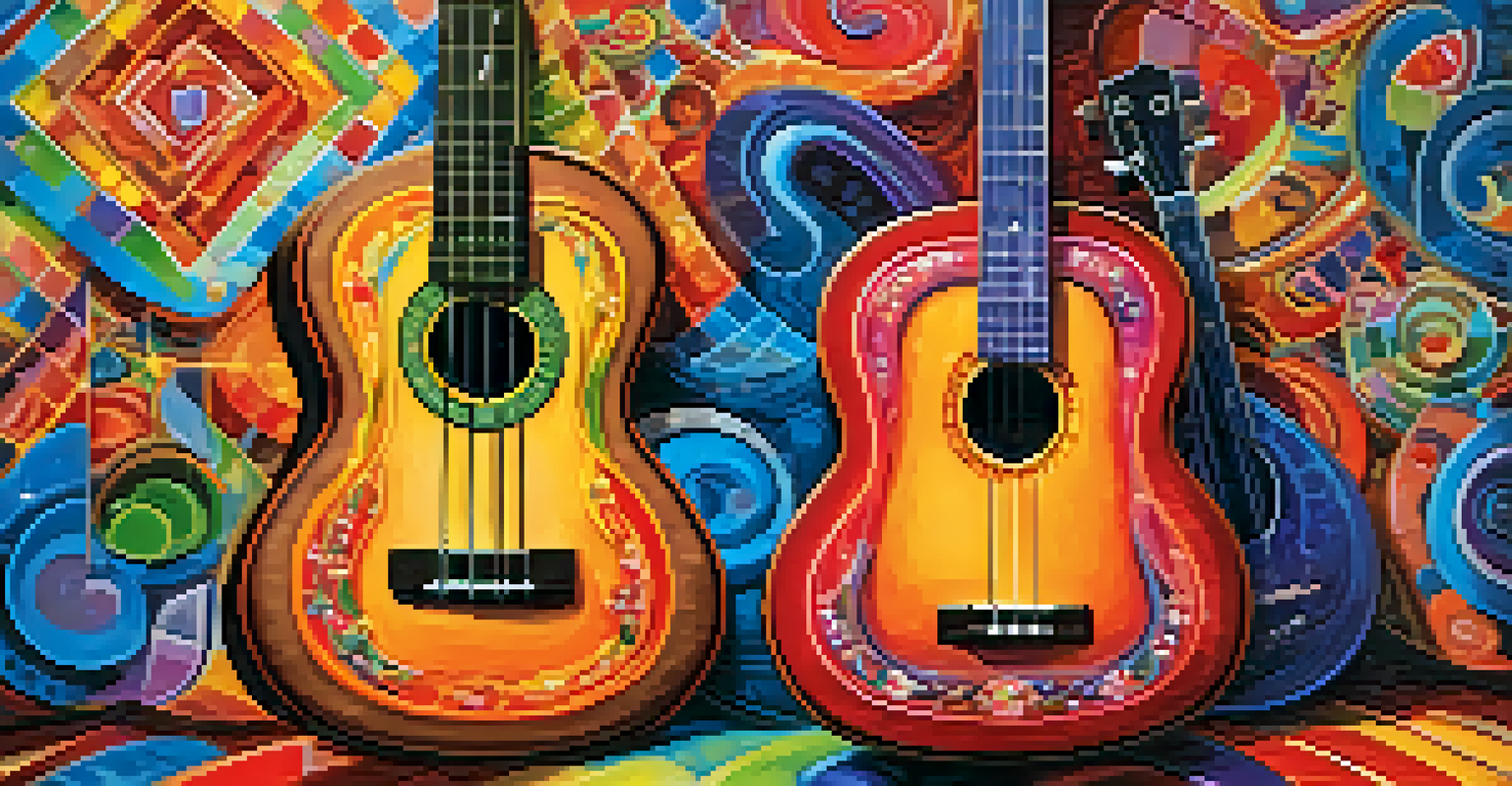Ukulele and Flamenco: A Cultural Musical Exchange

Introduction to Ukulele and Flamenco Music
The ukulele, a small string instrument from Hawaii, and flamenco, a passionate Spanish dance and music form, may seem worlds apart. Yet, both embody rich cultural heritages and emotional storytelling through music. Understanding these two genres opens a window to the diverse influences that shape our musical landscape.
Music can change the world because it can change people.
While the ukulele is often associated with cheerful Hawaiian tunes, flamenco is known for its deep, expressive rhythms and intricate guitar techniques. Both instruments, despite their differences, share a common goal: to evoke emotion and connect people through melody.
This article explores the fascinating interplay between ukulele and flamenco, revealing how cultural exchanges can lead to innovative musical fusions that resonate with audiences globally.
The Origins of the Ukulele
The ukulele traces its roots back to the late 19th century, influenced by Portuguese instruments like the braguinha. When Portuguese immigrants brought the braguinha to Hawaii, it evolved into the ukulele we know today. This transformation signifies how music can adapt and thrive in new environments.

Initially popularized in Hawaiian music, the ukulele quickly gained recognition in American pop culture during the early 20th century. Its light, cheerful sound and portability made it a favorite among musicians and hobbyists alike, allowing it to spread across the globe.
Cultural Roots of Ukulele and Flamenco
Both the ukulele and flamenco have rich cultural heritages, showcasing how music can evolve and adapt through different influences.
As the ukulele traveled, it absorbed various musical influences, paving the way for unique adaptations in different cultures, setting the stage for exciting collaborations like those with flamenco.
The Rich Tradition of Flamenco
Flamenco is steeped in history, originating from the Andalusian region of Spain. It combines singing (cante), guitar playing (toque), dance (baile), and even handclapping (palmas) to create a vibrant expression of emotion. Each performance is a narrative, often reflecting themes of love, struggle, and celebration.
Without music, life would be a mistake.
This genre's roots are deeply intertwined with the Romani, Moorish, and Jewish cultures, showcasing the rich tapestry of influences that shape its sound. The authenticity of flamenco lies in its improvisational nature, allowing artists to express their feelings spontaneously during a performance.
As flamenco gained popularity, it began to transcend cultural boundaries, inspiring collaboration and fusion with various musical styles, including the ukulele.
Cultural Crossroads: The Fusion of Styles
The fusion of ukulele and flamenco is a prime example of how music can transcend cultural barriers. Artists experimenting with this blend often find that the cheerful ukulele complements the passionate intensity of flamenco, creating a delightful contrast. This unexpected pairing invites listeners to experience familiar sounds in new ways.
Collaborative projects between ukulele players and flamenco guitarists highlight the beauty of this exchange. By combining the rhythmic strumming of the ukulele with the complex fingerpicking of flamenco, musicians create captivating melodies that resonate deeply with diverse audiences.
Fusion Creates Unique Musical Experiences
The blend of ukulele and flamenco offers a delightful contrast that invites listeners to appreciate the beauty of cultural diversity.
This fusion not only enriches both musical styles but also fosters appreciation for cultural diversity, encouraging listeners to explore the stories behind each genre.
Notable Collaborations and Artists
Several artists have successfully merged ukulele and flamenco, drawing attention to this unique cultural exchange. For instance, renowned ukulele virtuoso Jake Shimabukuro has experimented with various styles, even incorporating flamenco elements into his performances. His ability to blend these genres showcases the versatility of the ukulele.
Similarly, flamenco guitarist Vicente Amigo has explored collaborations with musicians from different backgrounds, including those who play the ukulele. His innovative approach encourages new interpretations of flamenco, expanding its reach and appeal.
These collaborations serve as a testament to the power of music as a universal language, bridging gaps between cultures and inviting fans to appreciate the richness of both traditions.
The Impact on Modern Music
The merging of ukulele and flamenco influences has left a lasting impact on modern music. Many contemporary artists are embracing this fusion, with songs that incorporate elements from both genres. This blend not only captivates audiences but also inspires musicians to broaden their creative horizons.
In recent years, music festivals and workshops celebrating this fusion have emerged, attracting participants from various backgrounds. These events provide a platform for artists to share their interpretations, fostering a sense of community among musicians and fans alike.
Impact on Modern Music Trends
The collaboration between ukulele and flamenco influences modern artists, inspiring innovative creations and fostering community among musicians.
As more artists experiment with this cross-cultural exchange, we can expect to see an exciting evolution in musical styles, celebrating the beauty of diversity in the world of music.
Conclusion: Embracing Cultural Exchange Through Music
The relationship between ukulele and flamenco illustrates the beauty of cultural exchange. As these two distinct musical styles intertwine, they create a rich tapestry of sound that resonates with audiences worldwide. This collaboration reminds us that music, at its core, is about connection and expression.
By embracing the blending of different musical traditions, we open ourselves up to new experiences and perspectives. This journey not only enriches our understanding of music but also fosters a sense of unity in diversity.

Ultimately, the fusion of ukulele and flamenco is a celebration of creativity that encourages us all to explore various musical landscapes, reminding us of the power music holds to bring people together.